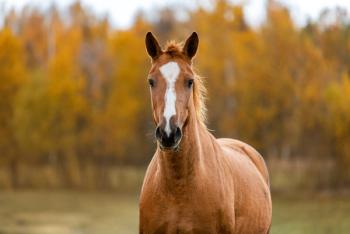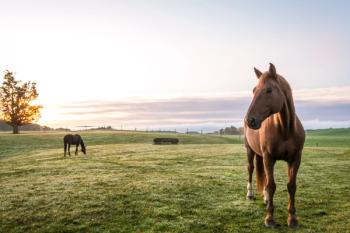
Storms strand hundreds - Veterinarians merge at Lamar-Dixon to reunite 80-90 percent with owners
Baton Rouge, La.—Louisiana State University (LSU) wasn't part of the state veterinarian's hurricane response or contingency plan before Katrina was a household name. But shortly after the large Category 4 storm ravaged Louisiana, Mississippi and Alabama, it became clear that unsolicited veterinary help would be needed on an unprecedented scale to rescue and relieve thousands of animals.
BATON ROUGE, LA.—Louisiana State University (LSU) wasn't part of the state veterinarian's hurricane response or contingency plan before Katrina was a household name. But shortly after the large Category 4 storm ravaged Louisiana, Mississippi and Alabama, it became clear that unsolicited veterinary help would be needed on an unprecedented scale to rescue and relieve thousands of animals.
Infrastructure for horse owners and foster farms will take longer to heal than treating rescuees. Animals turned loosed required saving, but most were able to survive the floods.
About 34 equine veterinarians practice in the disaster-declared areas of Mississippi and Louisiana, according to American Association of Equine Practitioners (AAEP) membership numbers; their operating status and levels of need were being assessed at presstime.
An estimated 45,000 horses lived in the seven Louisiana parishes affected by Katrina; thousands more lived in effected areas in Mississippi and Alabama. Hundreds were rescued and brought to staging areas in the three states.
"There was a plan in place by the state veterinarian's office and others, and to be quite honest, LSU wasn't really involved in that organizational chart pre-Katrina. But we soon became involved before the storm because many of the evacuated horses were being brought to Lamar (Lamar-Dixon Expo Center)," says Dr. Rustin Moore, director of Equine Health Studies at the LSU School of Veterinary Medicine in Baton Rouge, and coordinator for the LSU effort that became known as Horse Emergency Rescue Operation (HERO).
Katrina washed ashore early Monday morning, Aug. 29; the 17th Street levee was breached by noon, but conditions were too dangerous to conduct rescue operations for another two days.
"Then on Sept. 1., we set up the Horse Hurricane Help Line, and we started to get calls from everybody," Moore says. "Shortly after realizing the need, we set up rescue teams (see story). So we didn't have this great plan. We just started it, and it snowballed and grew until we were kind of coordinating the efforts."
Lamar-Dixon Expo Center, a multi-use event facility with emphasis on equestrian and 4-H activities, became a staging area that eventually evaluated almost 400 horses. It wasn't part of the original plan, either. But as Katrina moved through the Gulf of Mexico, the strength and span of the storm began to pique concern among planners, especially Bonnie Clark, horse unit coordinator under the direction of state veterinarian's office in conjunction with the LSU veterinary school equine health studies program and USDA veterinarians. She oversaw supplies, rescue operations and the return of animals with participating groups, but her first order of business was to establish relief barns that were close enough to the disaster area to be efficient but far enough away to weather the storm.
"I'm friends with the executive director at Lamar-Dixon, so I called and begged him to use the facility as a staging area, and he agreed."
With that last-minute verbal commitment, she met Dr. Denny French, LSU field service professor, to establish one of the largest equine relief centers anyone had seen. They started with nothing, not even a halter. By Sept. 1, the facility would bustle with enough feed, supplies and clinical support for 385 horses with medical charts and electronic identification logs. With just a few days planning with a volunteer crew, the operation was on track to convert displaced animals into discovered pets.
"We started out extremely well organized. We knew that we had 63 head coming in (Sept. 1), and we either scanned the microchips or registered their tattoos," French says. "The microchips have been a really good thing in cataloging the horses in. It has been a state requirement since 1994 if they don't already have some sort of lip tattoo or unique numeric number on them. That allowed them to have some sort of a database when they came in."
Horses qualify for disaster relief
French's field service students helped run the makeshift hospital by making rounds, assessing and treating the array of lacerations plaguing the animals.
The around-the-clock operation consumed the days and nights of many volunteers.
"I was sleeping in a stall for the first week," Clark says.
When DVM Newsmagazine spoke with French more than four weeks after the original 63 patients entered Lamar-Dixon, the staff only lost one horse after it arrived at the facility, and the team lost one horse off the trailer. About 190 of the 385 remained.
"At least 112 to115 of those are claimed, and the owners are just making arrangements to get them shipped out," French says. "I think what we are going to end up with about 70 to 75 horses of the 385 that will be a residual population."
Clark's meticulous record-keeping, first by notepad and eventually using a computer database, allowed horses to be reunited with owners and prevented much of the horse theft often seen in aftermath of hurricanes. She saw owners lament the loss of their horses first hand during Hurricane Andrew in 1992, when she lived in Florida and operated emergency shelters in the shadow of one of the largest storms to hit the United States.
"There were thousands of horses stolen in Andrew," Clark says. "That was the driving force. I wanted to make sure that didn't happen again. The return ratio that I'm looking at right now will be about 80-90 percent. As far as I know, it has never been done before."
Only four horses were unidentified at Lamar-Dixon.
Turn me loose
Many of the horses brought to relief centers in Hattiesburg, Miss., and Jackson, Miss., Sugarena in Iberia, La., as well as humane societies and shelters across the Gulf Coast, were able to be rescued because they were turned loose by their owners. Veterinarians from communities adjacent to those severely affected by Katrina were able to give valuable advice to horse owners when Rita pushed ashore days later.
"We saw barns full of dead horses in stalls," Moore recalls from viewing areas that were engulfed by the floods that followed Katrina. "It certainly seemed in our experience that horses that were turned out either because they lived outside already or because owners turned them out prior to the storm because they couldn't evacuate them, those horses fared better than those that where in stalls in barns."
Many of those barns are no longer there. Neither are the fences that enclosed pastures. A few racetracks are gone, too. Many say that the emergency care is easy compared to the task ahead: rebuilding.
"The rescue and treatment of the horses comes in the first three or four days after a disaster. Phase B, which is to me much more disturbing, are the horses that are given up two to three weeks after a disaster, says Dr. Jim Hamilton, chair of the AAEP Emergency and Disaster Preparedness Committee and a member of Veterinary Medical Assistance Team (VMAT) No. 3 since 1996. VMAT 3 was stationed in Hattiesburg.
"Owners are consciously handing you the lead rope and telling you that they can't do this; it is gut wrenching," he says with emotion in his voice. "They will almost at any cost try to keep that animal to make them think that their life is not destroyed as much as they think, when in reality, their life really is destroyed as much as they think and effectively, they can't afford to fix the barn, they can't afford to fix the fence and they can't afford to keep the horse. This plays out all over Louisiana, Mississippi and Texas right now."
Newsletter
From exam room tips to practice management insights, get trusted veterinary news delivered straight to your inbox—subscribe to dvm360.




